 |
 |
The Shetty Sisters Sparkle by A Seshan, Mumbai e-mail: aseshan@bol.net.in October 2002 |
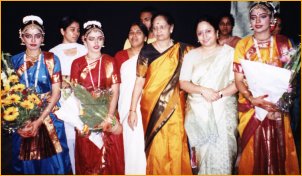 |
 |
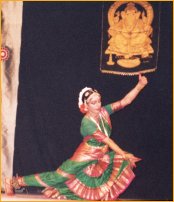 |
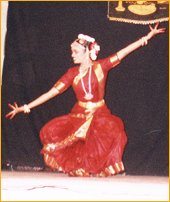 |
| The rasikas
of Bharatanatyam in north Mumbai were treated to a high-quality programme
at the Dr M Viswesvarayya auditorium in Mahim on Vijayadasami Day (October15,
2002). The occasion was the Ranga Pravesam or arangetram
of the Shetty Sisters – Surekha, Sarika and Chandrika – students of Kanaka
Sabha in suburban Chembur of which Smt Saroja Srinath is the Director.
She retired as the Head of the Department of Bharatanatyam at Dr Kanak
Rele’s Nalanda Nritya Kala Mahavidyalaya. Dr Siri Rama, her daughter,
is an exponent of Bharatanatyam and Kuchipudi and teaches in Mumbai and
Singapore. The event was looked forward to because the Sabha had not mounted
any programme for more than two years. Dr Siri Rama had moved out of Mumbai
to the international circuit and had been busy choreographing dance-dramas
in USA, Hong Kong and Singapore like the monumental production entitled
The Fifth Lotus in the last city, a joint venture with Chinese
artistes.
The total impression was one of immense satisfaction. At a time when exotic themes like 9/11 are choreographed and such bols as “bin laden dhinna” (instead of na din dhinna) are heard on the stage in a Kathak programme, it was refreshing to see, for a change, a classical Bharatanatyam performance of yore, presented in all its pristine purity. Right from the word ‘go’, the Shetty Sisters were totally immersed in their dance. Strictly speaking, it was not an arangetram for them. They had been participating in the dance-dramas of Kanaka Sabha for many years with distinction. So the local rasikas were familiar with their artistry, the maturity of which came through loud and clear. In fact, it is a good strategy for other aspiring dancers also to follow the route taken by the Sisters. It is better to gain experience by participating in small roles in dance-dramas before going to the stage for a full-fledged performance. The current trend in putting young dancers on arangetram with limited or no experience on stage leaves much to be desired. It is not in their own interest. The repertoire consisted of a Pushpanjali of Balamurali Krishna in ragatalamalika, an alarippu in tisra jati, a jatiswaram in Hamsanandi (Adi), Madhavacharya’s “Devakinandana” - a piece on Dasavataram - in Tilang (Adi), Muralidharan’s Tamil song “Raja Rajeswari" in Abheri (Misra Chapu), a Purandaradasar kirtana “Neene Anatha Bandhu” in Gurjari Todi (Adi), “Charanam Ayyappa” in Ananda Bhairavi (Adi) and a tillana of Dandayuthapani Pillai in Hindolam (Adi). |
 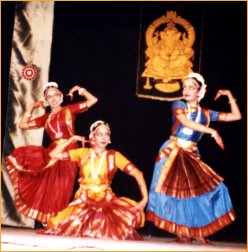  |
| In view of
the limitations of space and the uniformly good performance of the Sisters
it is better to give the highlights and the general impression instead
of going into the dancing of each artist or each item.
The first aspect that struck this reviewer was the excellent choreography, which made the transition from one item to another quickly with not a dull moment. There was a judicious allocation of time in a near two-hour performance. Thus Dasavataram occupied the centre stage in lieu of a varnam. The predominant stayibhava was bhakti although one saw other bhavas like krodha in Narasimha Avatar. While all the avatars were portrayed well, the fury of Narasimha depicted by Sarika was etched in the mind of this reviewer. This was done tastefully keeping both lok dharmi and natya dharmi in a judicious proportion. This writer had seen overdramatisation of the episode in other concerts with the pouting of tongues and other gestures that do not go well with the audience, especially when done by a beautiful girl. It was thoughtful on the part of the choreographer to have put all the three girls on the stage for Dasavataram, each one taking a turn to portray one avatar with the climax summing up all the avatars in a jiffy. Sanchari bhavas were done with restraint. Generally there is a tendency to recall the entire Mahabharata while enacting Krishnavatar. While this might have had its appeal in the past when people had the time to see them, in the current milieu it may only tire the viewer. The adavus were marked by anga suddha. This is what a critic looks for in a performance. The clean and crisp lines of the adavus reflected the eclectic training that the guru had imbibed from different schools (banis) synthesising them into a harmonious whole. The jumps (utplavan) were well executed. Chandrika is admittedly an expert in this area. Sarika’s solo performance was marked by a sense of merging with the character represented. Surekha’s depiction of Ayyappa was remarkable for the effortless execution of muzhu mandi. The Sisters matched their guru jati for jati. There was free and uninhibited dancing and a spirit of joie de vivre among the artists, who have an attractive stage presence. This writer has only a couple of critical comments. There was too much of bhakti bhava. Besides the one on Dasavataram, the Tamil song, described as a padam, also had bhakti sringara as stayibhava. Some other bhavas like the virahotkanditha nayika would have provided some variety and, say, a Kshetragnya padam could have been included. Again, given the long experience of the Sisters, one expected a varnam too. Costume designs were tasteful, the colours being chosen carefully. Each artist had her dress in a different colour avoiding the monotony of uniformity. The change of costumes after the interval was a good idea. The stage was simple. The programme was delayed because the earlier one did not finish on time. Still it was late in start only by 20 minutes thanks to a number of volunteers who prepared the stage without much loss of time. As a result, the stage decor consisted only of a picture of Lord Ganesh in the background and a statue of Nataraja in the foreground on the side. In a way such simplicity helped in the viewers concentrating on the programme without being distracted by other elements on the stage. The sound system was good and soft on the ears. This writer remembered another occasion at the ISKCON centre in Juhu where sitting in the front row was a misery as there was a blast of high-decibel sound from the loudspeakers. The technician justified it saying that it was done so as to enable the people in the last row to hear well! The success of the programme owed not a little to the support from the wings. Siri Rama was resounding in her nattuvangam and recitation of jatis. Mangalam Murthy was melodious and clear in her enunciation helped by a subdued, but at the same time supportive, role on the violin by Shantha Balasubramaniam. |
| Lalitakalalayam Nambisan was, as usual, in high spirits on the mridangam. Compering was done competently by Vidhya Mani, a dancer in her own right. While the choreographer is from Karnataka and the percussionist is from Kerala, the other two are Tamil-speaking. At a time when the Cauvery River issue has raised passions in both Tamil Nadu and Karnataka, it was a happy sight to see these artistes with different linguistic backgrounds in a cooperative endeavour marked by understanding. It set an example to politicians. | 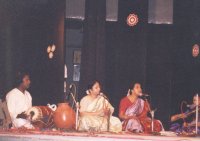 |
|
|
Nambisan, Siri Rama, Mangala Murthy, Shantha Balasubramaniam
|
||
| A Seshan is an Economic Consultant in Mumbai, formerly Officer-in-Charge of the Department of Economic Analysis and Policy in the Reserve Bank of India. He is a music and dance enthusiast and writer. |